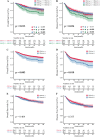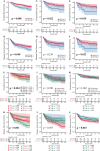Clinical correlation and survival analysis of hepatitis B virus infection in oral squamous cell carcinoma: a retrospective study of 1373 patients
- PMID: 40301863
- PMCID: PMC12042629
- DOI: 10.1186/s12885-025-14188-8
Clinical correlation and survival analysis of hepatitis B virus infection in oral squamous cell carcinoma: a retrospective study of 1373 patients
Abstract
Background: Chronic hepatitis B virus (HBV) infection poses a significant global public health challenge and is found closely related to extrahepatic cancers, including head and neck cancer. Oral squamous cell carcinoma (OSCC) is the major category of head and neck cancer. This retrospective study was conducted to explore the clinical correlation and survival analysis of OSCC patients with HBV.
Methods: The study involved 1,373 patients with OSCC treated at the Hospital of Stomatology, Sun Yat-sen University from 2012 to 2022. Propensity score matching was used to analyze the clinical correlations and survival outcomes, specifically overall survival (OS) and disease-free survival (DFS), in patients with or without hepatitis B surface antigen (HBsAg) seropositivity. Subgroup analyses were conducted for both the early and advanced stages of OSCC. The benefits of neck dissection in OSCC patients with HBV infection were further investigated.
Results: The prevalence of HBV infection in our cohort was 12.0%. The HBsAg (+) group had a higher percentage of individuals under 60 (73.3% versus 63.7%, p = 0.016). Post-matching for age, sex, pathological T category, pathological N category, and neck dissection, the OSCC patients with HBsAg (+) had lower 5-year OS and DFS rates rather than HBsAg (-) patients, especially those with advanced stage and cervical lymph node metastasis. HBsAg (-) was confirmed as an independent protective prognostic indicator for both OS (hazard ratio [HR] = 0.52; 95% confidence interval [CI] = 0.34-0.79; p = 0.002) and DFS (HR = 0.69, 95% CI = 0.50-0.96; p = 0.027). Notably, elective neck dissection was recognized as an independent protective factor influencing 5-year OS and DFS. While DOI and pathological N category were both confirmed as the risk factors for prognosis.
Conclusions: HBsAg is a potential prognostic marker for OSCC. It is essential to screen for HBV infection prior to initiating tumor treatment. Additionally, serological testing, antiviral prophylaxis and therapy play crucial roles in preventing HBV reactivation during the course of tumor treatment. In cases of early OSCC associated with HBV infection, elective neck dissection has been shown to reduce the rates of recurrence and metastasis significantly.
Keywords: Head and neck cancer; Hepatitis B virus; Neck dissection; Oral squamous cell carcinoma; Propensity score matching.
© 2025. The Author(s).
Conflict of interest statement
Declarations. Ethics approval and consent to participate: This study was conducted in accordance with the Declaration of Helsinki. Ethical approval for this study was obtained from the Medical Ethics Committee of the Hospital of Stomatology, Sun Yat-sen University (Approval No.: ERC-[2017]-26). This retrospective study was conducted in accordance with “Ethical Review Measures for Biomedical Research Involving Human Subjects” promulgated by the Chinese government. According to the regulations of the Ethical Committee of the Hospital of Stomatology, Sun Yat-sen University and the data usage requirements of biomedical databases, informed consent can be waived for this retrospective study. Consent for publication: Not applicable. Competing interests: The authors declare no competing interests.
Figures



Similar articles
-
Hepatitis B Virus Infection is a Prognostic Biomarker for Better Survival in Operable Esophageal Cancer: Analysis of 2,004 Patients from an Endemic Area in China.Cancer Epidemiol Biomarkers Prev. 2019 Jun;28(6):1028-1035. doi: 10.1158/1055-9965.EPI-18-1095. Epub 2019 Mar 14. Cancer Epidemiol Biomarkers Prev. 2019. PMID: 30872314
-
Survival outcomes of patients with head and neck squamous cell cancer with hepatitis B virus infection: An analysis from an endemic tertiary center.Cancer Med. 2023 Mar;12(6):6802-6810. doi: 10.1002/cam4.5469. Epub 2022 Nov 24. Cancer Med. 2023. PMID: 36426417 Free PMC article.
-
Neck dissection improves the prognosis of patients with early-stage oral squamous cell carcinoma.Sci Rep. 2025 Apr 4;15(1):11640. doi: 10.1038/s41598-025-96018-2. Sci Rep. 2025. PMID: 40185843 Free PMC article.
-
Lymph node ratio as prognostic variable in oral squamous cell carcinomas: Systematic review and meta-analysis.Oral Oncol. 2019 Feb;89:133-143. doi: 10.1016/j.oraloncology.2018.12.032. Epub 2019 Jan 8. Oral Oncol. 2019. PMID: 30732951
-
The budding and depth of invasion model in oral cancer: A systematic review and meta-analysis.Oral Dis. 2022 Mar;28(2):275-283. doi: 10.1111/odi.13671. Epub 2020 Oct 25. Oral Dis. 2022. PMID: 33031610
References
-
- Bray F, Laversanne M, Sung H, Ferlay J, Siegel RL, Soerjomataram I, Jemal A. Global cancer statistics 2022: GLOBOCAN estimates of incidence and mortality worldwide for 36 cancers in 185 countries. CA Cancer J Clin. 2024;74(3):229–63. - PubMed
-
- Cunha ARd, Compton K, Xu R, Mishra R, Drangsholt MT, Antunes JLF, Kerr AR, Acheson AR, Lu D, Wallace LE, et al. The global, regional, and National burden of adult lip, oral, and pharyngeal Cancer in 204 countries and territories: A systematic analysis for the global burden of disease study 2019. JAMA Oncol. 2023;9(10):1401–16. - PMC - PubMed
-
- Chow LQM. Head and neck Cancer. N Engl J Med. 2020;382(1):60–72. - PubMed
-
- de Martel C, Georges D, Bray F, Ferlay J, Clifford GM. Global burden of cancer attributable to infections in 2018: a worldwide incidence analysis. Lancet Glob Health. 2020;8(2):e180–90. - PubMed
-
- WHO Global progress report on HIV. Viral hepatitis and sexually transmitted infections. Accountability for the global health sector strategies 2016–2021: actions for impact. WHO; 2021.
MeSH terms
Substances
Grants and funding
LinkOut - more resources
Full Text Sources
Medical

